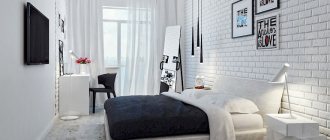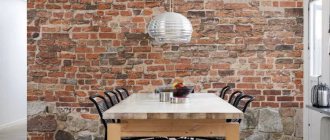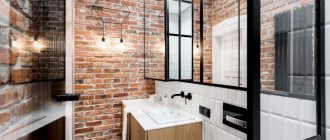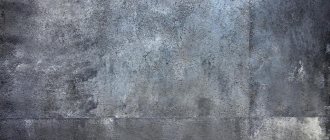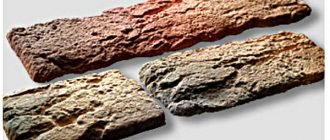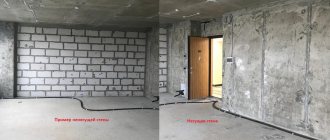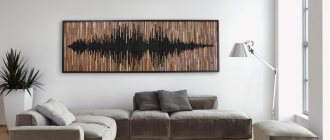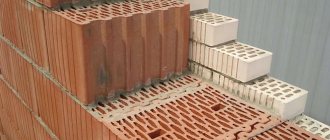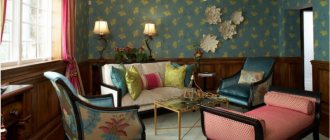There is probably no such person who has never heard of the loft style in his life. People never cease to admire its courage, practicality, simplicity and convenience. They spend a long time studying photographs of interiors on various design websites. Notice various design ideas for yourself. Creating an interior in the loft style must begin with the preparation and layout of the room, and decide on the finish for the walls and floor. In this article we will focus our attention on wall decoration.
The main distinguishing feature of a loft-style interior is brickwork. The best option is if the walls in your house are made of brick. Then you just need to wipe the cracks, clean and sand the brick from stains, plaque and dust, then coat it with varnish or paint.
Getting the seams in order
After all the preparations, there will definitely be voids in the seams; in addition, the removed bricks, if any, should be returned to their place.
For these purposes we will need putty. For interior work in rooms with little humidity, fugen gypsum putty is quite suitable; for exterior work or wet rooms, tile adhesive is well suited. Using putty, the bricks are inserted back, all voids and cavities in the seams are covered, holes and porous places on the brick should also be plugged. No trowels are required for this; just use your fingers and a frequently rinsed sponge. Having covered the seam with your finger, we then go through it with a sponge and remove everything unnecessary; anyone can do this operation! It is best to do this operation twice, be sure to miss something at once.
After caulking and drying the seams, it is useful to clean the whole thing with sandpaper and knock off all the burrs on the caulk.
Final cleaning of brick from plaster
Even when the entire wall is cleaned, small particles will remain on the brick itself. To perfectly clean all bricks from residue, you will have to arm yourself with a wire brush. The work is carried out starting from the top, which allows you not to stain the already cleaned brickwork.
The cleaned brick will need to be cleaned and subsequently varnished.
If the brick is strong, then you can clean it with a brush. Sandblasting of bricks is popular. If the brick collapses, it is better to use a rag for this. When cleaning, do not use chemicals. They do this only when really necessary.
The resulting brick wall will help give the room a very interesting look, which is part of many design solutions today. Designers use such a wall to create a specific style; for example, a high-tech or loft style involves creating one brick wall in a room.
You can carry out any design and repair work yourself. With a little effort and armed with the right tools, you can quickly and accurately complete the job on time. It is possible to clean a brick wall from plaster using various tools. Once you get the hang of it, you can do all the work quickly and efficiently using improvised means.
Cleaned brickwork can be refinished, painted and used as a design option. Brickwork can fit perfectly and be combined with various interiors. It can be classic, modern or mixed style.
White brick
Basically, everyone associates a loft with red brick walls, and preferably with pieces of cement, as if they decided not to finish the renovation and live just like that. But white color for brick is as natural as red. It does not stand out as much and attracts less attention, but at the same time it is less authentic and does not retain the atmosphere of factory premises. A combined option is also possible - leaving one of the walls according to the canons of the style.
White brick for the apron, and the walls are red
You don't have to use real brick. You can buy “brick” blanks or a special roller in the store to create the appropriate texture. This is a good option if you are doing a purely cosmetic renovation and do not want to “disassemble” the wall.
An all-white bedroom will look beautiful: a wall decorated with white brick, a snow-white ceiling, bedside tables, a chest of drawers, a desk and a light beige bed. Floors can be covered with natural wood of the appropriate species. Additionally, the interior will be decorated with black and white paintings and some unusual lamps.
White brick in the bedroom
Work order
How to remove plaster from walls, this question always arises when repairing and finishing a surface. After all, the old one will simply peel off, and the sagging will interfere with the work. Now let’s look at how to remove plaster from walls in more detail and detail.
Checking the strength of plaster
You shouldn’t immediately think about how to remove decorative plaster from the walls; there are options when you can leave it.
Attention: In cases where the destruction of the plaster is not significant and is focal in nature, there is no need to remove the finishing coating from the entire surface. However, when the finishing layer is destroyed everywhere, it should be completely dismantled.
- But in order to decide on the choice of complete or partial dismantling of the plaster, it is necessary to carefully examine the walls and ceiling for its strength.
- When a layer of paint or wallpaper is removed from the walls, the plaster may crumble. In this case, restoring this finishing coating will be a waste of time. It needs to be completely dismantled.
- To check the strength of the plaster layer, you can use fairly simple tools. First you need to remove all contamination with a spatula (scraper). If at the same time there is only slight shedding of the plastered surface, then it may only need to be renovated a little. To do this, you will need a solution made with fine-grained sand. You can also clean problem areas with sandpaper, prime them and putty.
- However, in order to find out how durable the plaster is, it is possible to use another tool. So, all you need is a spatula handle, a small hammer or a wooden mallet. Using the selected tool, you will need to carefully tap the surface. When a dull sound comes from hitting a plastered wall with a tool, this can only mean that there is a void under the finishing layer. And, of course, it needs to be dismantled and replaced with a new one.
- Despite the fact that you were the one who once plastered the walls and ceiling with your own hands, if the decision is made to completely remove the old finish, you will need to study it again to find out how durable it is. This is very easy to do and you only need to arm yourself with a spatula.
- You should tap the surface of the walls with its handle every 35–45 cm. If you hear a very loud sound, as if you are knocking on concrete, this means that the plaster in this place is holding very tightly. And if the sound is dull, then with a little effort, in such a place it will be possible to easily destroy a fairly large area of the finishing coating.
- You can also understand that the plaster mixture does not adhere very well to wet spots on it. However, this can only be observed in rooms where there is a high level of humidity.
- Cracks on the surface may indicate destruction of the plaster. If you find a plastered area that has at least one of these signs of destruction, then armed with a spatula, you can safely begin dismantling it.
Attention; It is worth considering that you should remove not only the layer that easily yields, but also go beyond its border by about 40 centimeters. But in this case, a spatula is unlikely to help you. And then other methods should be applied.
How to easily remove old plaster
Not in all cases does the entire layer of plaster need to be removed. And the presence of cracks may not always indicate destruction of the finish. Each specific case has its own characteristics and therefore requires an individual approach. But general rules, of course, exist.
Features of the loft style
A characteristic feature of loft design is not only brickwork, but also many other features that make the interior recognizable and aesthetically pleasing. This design trend itself originated in America in the 30s of the last century, when, due to the crisis, many people in cities were forced to rent premises in former factories and factories. This is where the style got its famous industrialism and brutality.
In addition to bare brick and concrete walls, loft designs feature an abundance of natural light. Huge windows were installed in the production premises, which let in enough sunlight to illuminate large industrial areas.
As furniture in the loft, only the most necessary interior items are used, without which it is impossible to live normally in the room - beds, sofas, armchairs, tables, chairs, shelves, etc. All of them must also be made in the same industrial style, only in this In this case, the apartment will look attractive and aesthetically pleasing.
The most popular colors in loft interiors: gray, brown, beige, black. Typically, cool shades and a lot of light colors are used, making the room visually look even more spacious and cozy.
In which rooms will a loft brick wall look good?
A loft-style wall made of brick or imitation will look great in almost any room. This design solution can be used for cladding:
- living room;
- bedrooms;
- kitchens;
- hallway;
- corridors;
- work rooms;
- balconies, etc.
Some owners of houses and apartments very successfully use this solution even when decorating children's rooms; a loft interior with white brick looks advantageous in any conditions.
Decor
The formation of the interior does not end with finishing, installation of cabinets and upholstered furniture. Various decoration items add completeness to the interior. It’s not difficult to do it yourself, but a professional decorator will do it according to all the canons of style.
Wooden decor in the form of a regular shield made of knocked together boards looks very appropriate on a brick wall. For this purpose, they are selected with a pronounced woodiness: knots, sapwood, cracks, aging, etc.
Loft paintings, graffiti, black and white photos, printing on billboards, posters, art and pop posters of past years. Ideally symbolize the loft theme, the lifestyle of people of yesteryear.
Wall decor is created using vintage figured frames from old paintings and mirrors. A combination of a pair of three such objects creates an interesting composition.
A window frame with peeling paint with old glass, a mirror or black and white photos placed in it is a hand-made technique to maintain style.
Loft wall lamps are an important attribute of the brutal character of the interior. Their lampshades are made of tin sheets, and their bases are made of metal parts of mechanisms, machine tools, and pipes. Spotlights, spots and large light bulbs - everything will emphasize the style.
Seams
The seams should be treated so that they stand out against the background of the brick wall. The most convenient way to do this is with a chisel. First we go through deepening the top edge, then the bottom. The result is slightly recessed “embroidered” seams, with clearly defined edges of the bricks. There is no need to clean the seams deeply, 2-4 millimeters is enough.
When the seams are cleaned, it doesn’t hurt to go over the entire wall with coarse sandpaper, finally removing all unnecessary material. We thoroughly sweep the wall from dust; a vacuum cleaner will be very useful. Next, the entire wall needs to be primed with deep penetration soil. You need to prime with a brush, penetrating into the most inaccessible recesses in the seams, not forgetting about the brick itself.
How to make imitation brickwork with your own hands
Imitating a brick wall is a fashionable way of interior decoration. You can do it yourself, following the step-by-step instructions.
Imitation brickwork
You will need:
- Primer.
- Plaster.
- Tile adhesive
- Spatula or special gloves for applying the solution.
- Cardboard or linoleum for creating a blank.
- Skin.
- Narrow masking tape.
- Acrylic paint.
- Brush or foam sponge.
Marking
First of all, you need to prepare the walls for further construction work. Clean the surface: remove the wallpaper, level the wall, smooth the surface using sandpaper.
After this, make a brick model. To do this, you can use either a piece of linoleum or cardboard. The standard size is 25x6.5 centimeters. On the sketch, it is necessary to mark the seams and mark indents of one and a half centimeters along the entire perimeter of the model from the outside. Make another seam in the middle to create an imitation of a brick consisting of two halves.
Models of bricks can be made from ordinary cardboard
IMPORTANT: you need to start laying out from the bottom - from the floor, gradually moving upward. This will make your work easier
From below you need to retreat about 10 centimeters. After this, use a simple pencil to outline the first corner “brick”. You need to start with this area, because it is the most difficult to make accurate markings on it. Then move to the edges, gradually moving towards the center of the wall.
Primer
The next step in creating an imitation brick wall is the primer. You can take any product, with the exception of concrete contact. It is diluted in the usual way indicated on the label. Using a roller, apply the solution to the wall. This must be done so that the imitation is strong and clear. Don't worry about the markings: they will remain in the same place.
Primer of walls
Application of the solution
Apply masking tape at the joints of the bricks. It is recommended to start with horizontal lines and then move on to vertical ones. The sticker must be overlapped.
IMPORTANT! Protect the floor with old newspapers or film. A solution for simulating bricks is prepared from plaster and tile adhesive in a one-to-one ratio
The mortar to imitate bricks is prepared from plaster and tile adhesive in a one-to-one ratio.
Using a spatula, apply the resulting solution to the wall. You can also do this with your hands, but do not forget to wear special construction gloves. The layer thickness should be within five millimeters.
Applying mortar to the wall
Using masking tape
Find the ends of the masking tape and pull them. Thanks to this, the space between the “bricks” is cleared. This must be done quickly, immediately after you have applied the solution to the wall. If you hesitate a little, you won’t be able to remove the tape. It is for this reason that gypsum is not used to make an imitation brick wall yourself (it hardens within a few minutes).
Finishing
If you applied the solution unevenly, you can give the imitation the required shape using a chisel, spatula or an ordinary tablespoon.
In this video you will learn 5 ways to apply brick-like decor, from the simplest to the most complex.
Painting
Sand the “bricks” to get rid of sharp corners on which clothing may later cling. Clean the wall surface. To do this, remove construction dust using a broom or brush. Prime the wall again. Walk not only along the “bricks”, but also along the seams between them. Then you can proceed directly to the painting process. Apply acrylic paint with a sponge to give the resulting wall a more natural color.
REFERENCE. After the paint has dried, you can age it a little. To do this, use a dry brush with gold paint to walk over the surface of the resulting imitation.
You need to choose the color of the walls based on your preferences. The only rule, perhaps, is that the color of the seams should be at least a few shades lighter than the color of the masonry, otherwise it will seem that a large amount of dirt has accumulated there.
The color of the seams should differ by several shades
To create the most cozy interior possible, use traditional red paint. If you want to expand the space, then give preference to light shades - white, milky, light blue, pink. You can also use dark colors, but they should be used in the interior in doses so as not to turn the room into a kind of gloomy crypt.
After reading our separate article, you can find out what a loft style should look like in white.
Watch the video on how to make a brick wall from plaster with your own hands.
How to remove decorative plaster from a wall with your own hands
Of the most popular tools, users will need:
- Special types of machines that remove plaster layers;
- Hammers;
- Metal brushes;
- cycle;
- Scrapers with spatulas;
- Hammers;
- Chisels. It is recommended to choose options with the longest handles. Then the process will be quick.
There are additional devices without which work is impossible:
- Spray;
- Damp cloth;
- Bucket with water;
- Film.
The walls must be constantly wetted, and in the final stages they are simply cleaned of accumulated dust. The bathroom excludes such requirements.
Methods for removing plaster using hand tools
These methods compare favorably with others due to the small amount of noise. There isn't much dust either. And no expensive tools are required.
The recommendations will look like this:
- First, you can tap the plaster layers with a hammer, which have begun to fall off in whole layers. Gypsum material is no exception.
- At the next stage, the edges are pryed up using a spatula. To drive it deeper under the plaster, they also go over the tool with a hammer. Then there are fewer problems with large layers breaking off. It is recommended to periodically moisten the surface with water so that not so much dust is formed. If something does not lend itself to a spatula, such areas are left for later, for other methods. Decorative material often requires that dismantling be carried out with special tools.
Old plasters come off with the same quality from concrete and brick bases. But what to do if drywall is used for the base function? The main thing is not to violate the overall integrity of the material and the paper layer. Then the hammer doesn't help. It’s better to start from some corner and pick out part of the coating with a knife. Then they move on to using cycles. The tool differs from a regular hammer only in its pointed end. So the putty is gradually lifted out, driving deeper and deeper under the solution. A chisel is also acceptable, but it is important for it to maintain an acute angle.
Chisels and hammers are needed if sufficiently large forces are applied. This option is suitable for materials that hold quite tightly. The surface is divided into small fragments to simplify the work. You have to knock while continuing to move in one direction.
The use of special hatchets when removing materials is one of the oldest methods. A wooden house is processed according to the same rules.
Dismantling methods using power tools
The issue is solved with the following devices:
- Bulgarian. Electric drill with chiselling mode;
Hammer drill
It is acceptable when layers of old mortar that are not capable of boasting high power are removed. The blows of this instrument are characterized by frequent blows with low power and amplitude. Such drills can even pierce bricks with the right approach.
The layered layers are removed completely or cut into fragments using various nozzles. The work is performed with metal bristles or cup attachments. The use of drills with a brush helps to completely clean the surface and get rid of the thin old layer. The same rules apply if loft is being processed, square meter and area do not matter.
This is an angle grinder or grinder. Some of the attachments on this tool are just right for removing different types of plaster finishes. In this case, abrasive wheels or brush attachments are combined with gypsum compounds, loose and sandy coatings.
The grinding machine performs the so-called “grinding”. It has special rollers with teeth in the sole. When they rotate, only the old layer of material needs to be removed. There is another attachment - a scraper, which also helps to cope with the work. Even a beginner can easily clean the surface using this method.
Hammer
Getting rid of plaster with a hammer drill is the easiest way. Nozzles that look like blades are used. The tool must be set to crushing mode. When placing the spatula on the surface, maintain an angle of 80 degrees. Then the thickness is pierced to the very base. The next tilt is 30-40 degrees, when the tool is re-driven into the mass. The method is simple with durable plaster compositions.
If the work is periodic at the everyday level, then amateur varieties of the tool are sufficient. Professional devices are purchased if more frequent and strenuous actions are required, and something needs to be cleaned constantly.
Dust-free methods
The surface requires moisture, which is provided by sponges with water or sprayers. The layer of plaster will swell after some time, then it can be easily removed using any hand tools. The wall will need to be re-wetted while the work is being done.
Less commonly used is a practically water-jet type of machine with low pressure. Such a tool may cause too much moisture to form on the floor. This is an expensive type of equipment, relevant for professional builders who clean surfaces.
How to clean a brick wall
The first step is to get rid of the plaster from areas where it has ceased to stick at all. Simply tapping with a hammer is enough to obtain information about the surface and its condition. Muffled sounds indicate that peeling has begun. If the sounds are ringing, it means that the adhesion of the old composition is strong.
Decorating the living room and bedroom
The living room is traditionally considered the most spacious room in any house or apartment, so it is the easiest place to decorate the interior, observing all the loft traditions. The main requirements are good lighting and a minimum of furniture. In this case, choosing wallpaper is quite easy. You should not give preference only to cold shades - several walls should be decorated in light and warm colors.
For the living room, plain wallpaper with an ornamental pattern is suitable, which can be used to decorate one or more walls. The accent on this loft background will be patterned glossy wallpaper that imitates natural materials. An accent area would be around the fireplace, next to the TV, or behind the sofa.
A loft bedroom should be cozy, relaxed and minimalistic, not overloaded with furniture and accessories. Accordingly, it is better to select plain and not very bright canvases. The accent in such an interior can be imitation materials or textured wallpaper. Most often, the bedside area is chosen for such purposes. Warm colors will add coziness to the bedroom. It is better to give preference to terracotta, sand and beige shades. The classic white color for bedrooms will be appropriate in any interior.
It is not recommended to style a children's room as a loft, since this style will be incomprehensible to children who need to create a comfortable home environment, rich in bright colors. But for teenagers, a room decorated in a street style is a completely suitable option. Wallpaper with graffiti or pictures from comics will be relevant here, but you should still rely on the tastes and preferences of the occupant of the room.
Loft style: how to make a brick wall in an apartment
A brick wall in a residential interior has been a current trend for many years now. The brutal texture of brick finds its place not only in art spaces decorated in the loft style, but also in the interiors of typical Russian apartments. Bare brickwork or its imitation is a bold alternative to traditional smooth walls covered with wallpaper or paint. This article will tell you what to combine with a brick wall in an apartment and what materials to make it from.
How to beat a brick wall in a loft interior
The loft style comes from the factory districts of New York. In the middle of the last century, the first loft spaces were budget housing in abandoned industrial buildings. The city authorities rented out such properties as apartments to the low-income population, with the condition that repairs would be borne entirely by the residents. That is why the brick walls for the most part remained bare and existed in the interiors in their original form.
Such spaces were often inhabited by people of art and students leading a bohemian lifestyle. As legend has it, representatives of the local elite periodically visited them at parties, who were delighted with the bold interior design in the form of exposed brick. This is how the fashionable loft style was formed and went to the masses, and the rough texture of brick walls became its calling card.
Today, the interior of a loft-style apartment involves bold design experiments, the purpose of which is to emphasize its original industrial aesthetics.
Against the background of the loft wall, decorative elements in an industrial style look impressive: LED signs, road signs, witty posters, graffiti and “industrial” lamps. The role of a decorative element can be taken on by exposed utilities, for example, open electrical wiring.
Brick in loft spaces organically interacts with leather upholstery, coarse textiles, metal structures, sports equipment, bright color accents and contemporary art objects. A brick wall can be just as impressive using contrasting stylistic techniques: massive mirrors in twisted baroque frames and wall candelabra in the neo-Gothic style.
In a loft interior, the classic red shade of brick is most common, but brick in white, gray and even black will also look relevant.
If the brick wall in the interior has a natural terracotta color, to illuminate the space you should choose a warm light spectrum in which the shades of the brick will “come to life.”
The lighting scenario of such premises always includes several levels and can use a variety of lighting devices: rotating spotlights, floor lamps, table lamps, low-hanging chamber lamps, LED lighting and signs.
The loft-style bedroom from Mossebo's April projects demonstrates an original solution for the wall at the head of the bed. In the niches of the white plasterboard body, natural brickwork is visible, illuminated in a warm spectrum using an LED strip. At the same time, niches represent a non-standard alternative to bedside tables and can be used to store household small items and place decorative elements.
Loft style and more
“Naked” brickwork is, of course, the main style-forming element of the loft space. But the brutal texture of brick has a place in other interior styles:
- A white brick wall in the interior is a frequent guest in apartments decorated in a laconic Scandinavian style. Natural red brick may also be present in a Scandinavian interior, but since this interior style is based on a light color scheme, the brickwork, as a rule, also takes on a light shade.
- The charming rural aesthetics of styles such as country and Provence also welcome brick walls, both painted and natural. Brick is found a little less often in rustic interiors, since this style gravitates more towards wood, using it as the main finishing material.
- The classic English interior is also no stranger to brick walls, combined with a fireplace, a cozy chair in front of the fireplace and bookshelves.
- Neo-Gothic is a rare phenomenon in Russian interiors and another style that gives preference to walls with a rough texture. To this day, connoisseurs of interior Gothic are inspired by the brickwork of medieval castles. In such spaces, brick organically interacts with forged furniture, wall candelabra, intimate lighting, dark tones and rich color accents.
- Mediterranean interior design also actively uses terracotta brick and natural stone or imitates their textures using other finishing materials.
- In eclectic interiors created at the intersection of several stylistic trends, there can always be a place for an accent brick wall.
Brick texture in white from the Mossebo project at the intersection of Scandinavian style and loft.
How to make a brick wall in an apartment
If you have a living space with uneven brick walls, use this gift of fate and save on decorative coverings. An experienced designer will be happy to work with the original brick texture, and craftsmen from the work team will bring the old walls into shape. During such work, raw brick is cleaned of cement, dirt and salt stains using an acid-containing solution. Then the wall is washed and coated with water-based varnish. All irregularities can be rubbed and sanded, and the wall can be painted or painted with graffiti.
Creating a loft style with your own hands
A combination of new and aged textures, coatings and materials would be appropriate. By skillfully combining stylistic elements, it is possible to achieve an urban atmosphere. The loft-style hallway needs special attention, as it is the beginning of getting acquainted with the housing. This space requires increased lighting and predominantly light shades.
The most commonly used color is gray. The kitchen is placed in the corner of the living room, giving it a small space. Loft style kitchen design involves an abundance of metal and glass. The basis of the interior in the living room is a wooden floor, rough wall decoration and a heavy sofa. The space near the sofa is filled with furniture, avoiding cluttering the space. The bedroom, as a rule, is separated by a screen, partition or wall from the rest of the space. In a room with high ceilings, the sleeping area is located on the upper level.
Decorating a house in the loft style is much easier than decorating an apartment. The decoration of the exterior of the home shows the lifestyle of the owners. Owners of brick houses often adhere to an urban style inside and outside the building. The desired image is created by a rough wall covering, and you also need to consider many large windows and a dark roof color.
Wall treatment
If the object for design is a home with brick walls, this can be used as a decorative covering. Processing of the original wall texture will be required. You can bring the old brick to normal condition with your own hands or resort to the help of special craftsmen. During work, the brick is cleaned of dirt, cement residues and salt stains using acid-containing mixtures. Then the masonry must be washed and varnished. The uneven surface is rubbed and polished. You can paint graffiti or paint a brick wall.
Types of materials
For loft-style finishing, it is preferable to use simple, natural materials:
- Wood. This wall covering blends harmoniously with a wooden floor. It is best to leave the material in its untouched, slightly rough-hewn state, maintaining its raw appearance;
- Concrete and plaster. Rough concrete walls will give the style a distinctive setting;
- Stone. When using this material, a feeling of comfort and tranquility is achieved;
- Metal. The most commonly used is stainless steel, which is painted graphite black. The walls and ceiling are decorated with metal pipes, beams and frames.
- Glass. Using glass walls and partitions, it is possible to maintain the volume of the room and zone the space.
- Brickwork. A profitable interior solution for any room. With the help of brick and other materials, you can create style accents and make the space original and unique. The choice of brick color depends on the goals in the interior: white color will expand the space, filling it with light;
- finishing with red brick will add coziness to the room;
- Accessories look great against the backdrop of black brickwork.
Such a popular loft: 5 steps on how to paint a brick wall
For years now, brick has served not just as a building material, but as a real basis for creating popular loft interiors. It is on brickwork that this original industrial style is built in modern houses. And the more interesting the walls are decorated, the more expressive the loft interior design looks. Let's talk about how to refine a brick in 5 steps and make it an interior decoration.
Surface preparation. 3 steps of necessary work
Brick is a mineral porous material. It actively absorbs applied varnishes and paints, dirt and dust. Therefore, before painting a brick wall, evaluate its condition.
- If the building is not new and the walls have already been painted, remove all previous coatings from the surfaces. Take a brush and remove the old paint from the brick. Repainting will not work - over time, the old layer will begin to peel off, crumble and spoil the new coating.
- After cleaning, sweep the walls, wash them with soapy water and leave to dry. Any material fits well on a clean and dry surface.
- Apply TRIORA deep penetration primer to the walls. It penetrates into the surface of minerals to a depth of 5 mm and firmly adheres to all microparticles. Primed brick will not crumble or absorb paint. The paint consumption will be reduced, resulting in an even coating.
How to make it yourself
Few people know, but it is quite possible to make loft-style bricks, which are popular nowadays, with your own hands. This will not take much time and effort.
It will be very good if the walls in your home are initially made of brick. In this case, you will only need to wipe all existing cracks, as well as clean the bricks from various stains and contaminants. It will be necessary to get rid of dust and plaque. Next, all that remains is to cover the masonry with paint or varnish.
This is done like this:
- water-based formulations are used;
- dilute the coloring composition with water and mix well;
- water must be added until the mixture acquires a translucent tone;
- Next, each brick must be treated with the resulting composition using a sponge;
- during the impregnation process, the bricks will be painted;
- there is no need to treat the entire base at once - start with a small area;
- After completing all work, be sure to wait until the paint/varnish hardens.
A beautiful and common choice of finish is imitation made from a plaster mixture.
This method has the following advantages:
- inexpensive;
- is environmentally friendly;
- does not take up useful space in the room;
- available for self-administration.
Materials and tools you will need:
- separate container for diluting the solution;
- special tile adhesive and plaster mixture;
- masking tape;
- narrow and wide spatulas;
- rules and level (it is better to take a laser or bubble).
First, you will need to prepare the walls in the room for future decorative decoration. The surfaces must be cleaned of the previous wallpaper, and all differences must be smoothed out with sandpaper. To ensure that the mixture adheres reliably, before laying the mortar, you should treat the walls with a primer using a roller or brush.
Now you need to mark the wall using masking tape. The usual parameters of a brick are 25x6.5 cm, and the indentation is 1.5 cm. First you need to paste over the horizontal stripes, and then proceed to the vertical ones. To prepare the solution, we use glue and plaster in proportions of 50x50. After this, apply the prepared composition with a spatula (this can also be done manually, if desired). Try not to touch the ends of the tape.
After applying the composition, the tape between the individual “bricks” must be removed. To give the masonry a more natural shape, you should use a chisel or a tablespoon. Then you need to clean the surface with sandpaper. Next, you will need to prime both the bricks and the seams between them.
If treating walls with plaster mixtures and paint coatings does not appeal to you, then you can turn to another common way to bring a brick wall into the interior - hanging wallpaper that imitates brickwork. You won’t have to regularly maintain this surface, spending extra money. You will just need to wipe off dust from time to time using a slightly damp cloth.
However, it must be borne in mind that in most cases such surfaces immediately reveal their unnaturalness. Their appearance is much inferior to natural stonework, especially if the print on the canvas itself is mediocre. There are often cases when such finishing reduces the cost of the interior, sometimes making it ridiculous. That is why wallpaper for brickwork needs to be chosen especially carefully so as not to spoil the decor in the house/apartment.
Brick wall - surface preparation and mortar application
First, let's prepare the walls for work. Thoroughly clean the surface of old wallpaper and smooth out any unevenness using sandpaper. To ensure that the mixture adheres firmly, before applying the solution, the walls are coated with a primer with a roller or brush.
Next, mark the wall using masking tape. Standard brick dimensions are 25x6.5 cm, indentation is 1.5 cm. First we glue the horizontal lines, then move on to the vertical ones.
To prepare the solution, we use tile adhesive and plaster in a ratio of 50 to 50.
Next, apply the prepared solution using a spatula. You can do this with your hands, so the surface will be more uneven, which is what we need. The main thing is not to seal the ends of the tape, because after applying the solution you need to tear it off (this must be done immediately after applying the mixture so that it does not have time to harden) this is the whole secret of this method. You cannot use plaster - it dries instantly.
To give the brickwork a natural shape, use a chisel; if you don’t have one, you can use a regular tablespoon. Next, clean the surface with sandpaper.
Then we prime, it is necessary to prime not only the bricks, but also the seams between them.
Have no doubt, the result will exceed all your expectations!
Brick wall - imitation
The simplest and most budget-friendly option for simulating a brick wall is wallpaper with a brick print. This surface is easy to care for - you can simply wipe it with a damp cloth. The disadvantage is that the surface is unnatural, and the end result does not look very attractive.
Another common option is decorative brick-like stone. The surface of this stone is covered with glaze, so with proper care it will last for a long time. And this coating looks very natural, but in terms of budget this option is very expensive.
The most optimal and beautiful finishing option is an imitation brick wall made of plaster.
Advantages of this method:
- no large financial costs required
- environmental friendliness - the plaster contains no harmful substances
- the space will not decrease - the layer is quite thin
- you can handle it on your own, there is no need to call specialists
Materials and tools:
- bath - for administering the solution
- tile adhesive and plaster
- masking tape
- wide and narrow spatulas
- construction rule and laser level
How to treat red brick from moisture?
Impregnations and water repellents are used specifically to protect bricks from high humidity. Moreover, it must be applied first to the external walls. ... There are 4 types of these mixtures:
- Water-repellent impregnation for bricks. ...
- Varnish impregnation. ...
- Silicone-acrylic waterproofing mixture.
- Water-based silicone protection.
4 Apr.
2022 Interesting materials:
My rights have been taken away, what should I do? The wallpaper has come off, what should I do? Recalled from vacation, what to do with vacation pay? The defendant does not comply with the settlement agreement, what should I do? Waiting for the play market to download, what should xiaomi do? The coat shrunk after washing, what should I do? The coat has rolled up, what should I do? The phone's memory is full, what should I do? The folder is not deleted, what should I do? What should you do before confession?
Loft in the interior
Giving an apartment the image of a factory warehouse, technical room, or attic is quite simple in our time, due to the availability of projects, a wide range of materials and relatively reasonable prices. The work is easy to do even by yourself, focusing on ready-made designs by designers and photos on the Internet. But an apartment is a place intended for relaxation and the interior walls must correspond to this. Coziness, cleanliness, comfort, despite the rough style motives, are relevant for industrial projects.
Free creative people, students and other pioneers of the loft in America in the 30s, having no funds for repairs, did everything with their own hands and used for this purpose whatever came to hand. And those parts of the industrial areas for which there were not enough materials remained as they were.
Walls 4-5 meters high are not easy to decorate. And in combination with their considerable length, there was an impressive area, which required funds that few of the “discoverers” could afford. The maximum that was done to give at least some refinement to the interior was to paint the walls and decorate them with improvised means. But this is rather an exception; often the brick, wood or concrete surface remained untouched.
How to fill it out correctly
Natural materials are used as the basis for design: concrete, brick, and sometimes wood. Rough texture and a huge amount of different lighting with aged things are typical for any room in this style.
In design, it is important to use natural materials or their imitation
The surface is poured with concrete or tiled. Imitation of natural granite or wood in black looks modern in the bathroom. Ordinary clay tiles without any ornaments in a light color expand the room.
Self-leveling floors are used from a practical point of view. Insulation is installed first, which is poured with concrete or covered with tiles.
Most often, the floor is tiled to look like wood or filled with concrete.
Ceiling
From time to time it is laid out with concrete slabs. There are ceilings that are one hundred percent covered with pipes or an iron frame. The ceiling can simply be painted snow-white, which, in contrast with the floor, will also expand the small room.
Walls
Brick gradually fades into history, but remains popular. Imitation finishing is suitable for an economical option. From time to time all types of finishes are combined.
The bath area is decorated with clay tiles, the area for drying and small aqua procedures is decorated with concrete masonry or brick. It is risky to use wood panels for a combined bathtub; such finishing material will not last long.
Multifunctional areas can be decorated with various materials
Peculiarities
The attic style called loft originates in New York in the 20th century. In those days, the authorities actively moved industrial enterprises away from the city. The vacated areas were given to poor citizens, asking mere pennies for rent. Without much money, people began to live in an environment of iron, brick and wooden walls without any decoration. Sometimes such boring and harsh foundations were decorated with various decorations.
As for the urban bohemia, its representatives began to organize various kinds of meetings in what were once industrial buildings. Both architects and artists did not ignore such constructions. They let their imagination run wild by designing such brutal dwellings. Walls made of wood and brick were covered with lime, thoroughly sanded or varnished.
Today the loft style has a lot of fans. Interiors designed in this direction are rarely complete without brick and stone walls. This decoration has become a real loft style tradition. They resort to it both when decorating houses and when decorating city apartments. Against such a rough background, a variety of pieces of furniture look great - from expensive leather sofas to soft armchairs with ethnic patterns. This is what makes a loft different – it often mixes many different stylistic trends.
Other important features of this famous style include the following aspects.
Availability of significant free space. Loft-style rooms usually have high ceilings and elongated windows. The interiors contain sharp contrasts that zone the available space.
In such settings there are both antique details and the latest trends in fashion and technology. Various communications are often not covered by anything and remain in plain sight.
Brickwork on the walls is common in the loft style. Moreover, the bricks themselves (natural or imitation) can have not only traditional red, but also gray, brown or another interesting color.
In such interiors, cool and light colors predominate, especially when it comes to finishing high ceilings. The use of white brickwork or exposing masonry areas is a traditional technique. In the future, the bricks can be painted or remain untouched.
Unusual lighting fixtures and accessories are common details in loft interiors. Overly rich and pretentious elements are usually absent in these settings.
Brickwork of different colors is in trend today, especially if it is made in a loft style. These finishing options look great in a variety of rooms. This can be not only a stylish living room, but also a kitchen or bedroom. In many rooms, imitation natural stone is often installed. For example, it could be smooth brick tiles. This material is great for finishing the kitchen, because it is not susceptible to contamination and can be easily cleaned from any stains if they appear.
The main thing is that all the details match each other in shade. The result is often very interesting and original ensembles that attract a lot of attention.
External and internal brick wall decoration
Brick walls in the interior have always existed, at least since brick itself was invented. Anyone who lived “under socialism” probably remembers how fashionable it was to cover walls with “brick-like” wallpaper, which was in short supply at that time. With the change in formation, this type of decoration began to seem hopelessly outdated.
However, times go by, fashion returns and the brutal loft style has revived interest in brick and elevated it to the category of one of the most sought-after materials.
Brick wall
Loft style brick for interior decoration:
Loft came to us from Manhattan, where abandoned industrial buildings were first used as housing. The new inhabitants (mostly representatives of New York bohemians) left the raw brick walls untouched, which in no way detracted from the originality of the interior, but, on the contrary, added chic. Over time, the style spread; its individual elements can today be found in the design of both ordinary and luxury housing.
Brick finishing in loft style
Decorating a living room in country style with decorative bricks:
Another direction, which is characterized by the widespread use of brick finishing, is country music in general and the numerous ethnic styles that join it: English, Mediterranean style, in particular French Provence or the Parisian attic style. At the same time, the comfort of a country (not necessarily village) house will be emphasized by the warm natural color of the brick, and the whitewashed textured walls will remind you of the sunny coast.
Decorative brick decoration for a living room in country style
Newfangled trends also fully welcome brick finishing. Strict and laconic high-tech and minimalism, which dictate simplicity of solutions and forms, gladly use the graphic nature of this material. Brown masonry, adjacent to neat white, gray, black, adds variety to the interior and only emphasizes its urban essence.
Brick can be used to decorate any room. It is usually used to decorate a wall or part of it that should be highlighted - behind the back of a sofa, at the head of a bed, directly next to a table in the dining area, near a fireplace or under windows. How to create masonry in the interior? This question is unlikely to arise for those who live in a brick country house or in a brick high-rise building. Of course, you will have to work with such a wall: wash off traces of cement and construction dust with a special solvent, sand it, rub the seams, and then coat it with water-based varnish. Residents of the “panel” have the option of finishing with thin-walled facing brick (it is noticeably thinner and much lighter than the real thing) or clinker tiles “like brick”. Many do not see the difference between these two materials, calling both facing bricks. However, the tile, which is called brick veneer, is still thinner. Decorative brick can convey the effect of antiquity or the effects of fire; it is available in a wide palette - from white to red-brown and even darker shades.
Brick wallpaper in the interior:
Well, the most affordable way to “lay out” a wall or part of it with brick is good old wallpaper. These can be paintable canvases that imitate the texture of masonry; photo wallpapers reproducing various options for a brick interior; self-adhesive film with a corresponding pattern. This option is especially suitable if you need to decorate a small, not the most noticeable part of the wall, for example, a deep niche in a dark corridor or a corner behind a hanger in the hallway.
“Boar” tiles in the bathroom and kitchen
A “hog” is a tile that looks like a brick, and is laid in such a way that two tiles touch where another tile in an adjacent row is in the middle. In the kitchen, you can make an apron from a “hog” (it’s easy to wash).
Cubes If you want a more brick-like look, we recommend using matte white.
White kitchen with boar tiles
White tile kitchen backsplash
The bathroom can be finished with such tiles almost completely, or by “dividing” the wall into two parts and finishing only the lower part with a “hog”. In this case, it is better to take a large square tile for the top one.
White boar tiles in the bathroomPainting
Walls are painted to suit every taste and color with water-based or water-dispersed paint; if the walls are external, the paint should be façade. The advantages of water-based paint are that it does not need to be removed later for subsequent painting, there is a huge selection of colors and it is practically odorless.
There are two color options: bricks and seams are painted the same color, or bricks contrast with the seams. In any of the options, you need to start painting from the seams, and then move on to the bricks. The seams can be painted well only with a brush, and the bricks can be rolled out with a roller. However, if the masonry is too uneven and the bricks are not at all flat, they will also have to be painted with a brush, preferably using the tamping method.
It is worth mentioning that you can cover the walls with clear varnish. This method is relevant when the seams are neatly sealed and the bricks are not smeared with putty and the seams are visually clearly visible.
